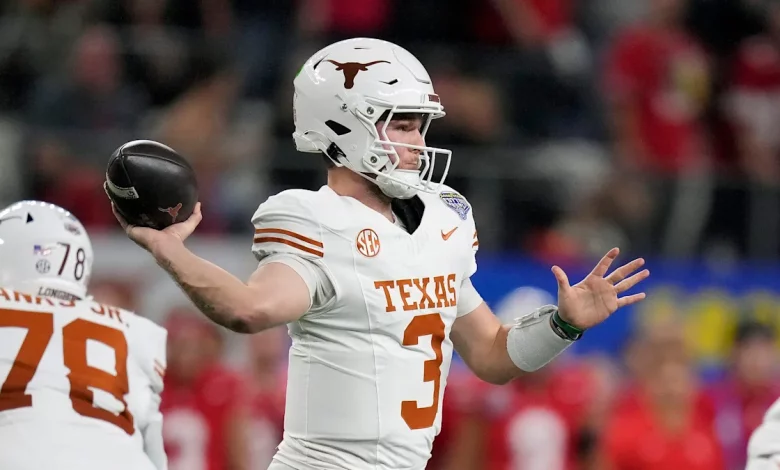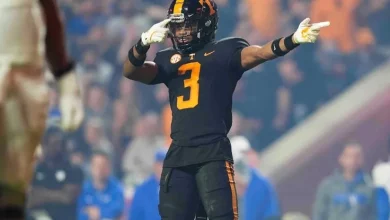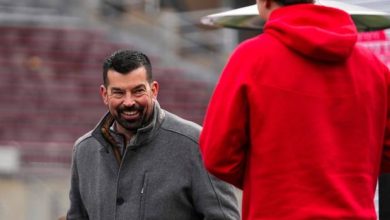Quinn Ewers could’ve earned ridiculous NIL money for transferring

The world of college football has seen a seismic shift in recent years, with NIL (Name, Image, and Likeness) rights allowing student-athletes to capitalize on their fame and talent. This change has completely altered the landscape of college athletics, particularly for high-profile players like quarterbacks. One of the most fascinating examples of how the NIL system could have been a game-changer in recent times revolves around Quinn Ewers, a young quarterback who made headlines for transferring from Ohio State to Texas in 2022. Ewers, a top recruit, had already garnered significant attention and NIL deals before making the move, but it’s clear that his transfer could have led to even more lucrative opportunities had he navigated the NIL world a bit differently.
In this article, we will examine why Quinn Ewers could have earned ridiculous NIL money for transferring, breaking down the factors that made his transfer so significant, the opportunities presented to him, and what his potential earnings could have been had the NIL system existed earlier or if he had maximized his potential in the space.
The Rise of Quinn Ewers: A Star is Born
Before we dive into the specifics of Quinn Ewers’ potential NIL earnings, it’s important to understand why Ewers has been such a prominent figure in college football.
Quinn Ewers was a highly coveted quarterback prospect coming out of Southlake Carroll High School in Texas, one of the most decorated football programs in the state. Ewers was widely regarded as the No. 1 overall recruit in the 2022 class, earning comparisons to NFL stars from the moment he stepped on the field. His skill set, particularly his arm strength and ability to make all the throws at such a young age, was drawing significant attention, and every college football program was eager to secure his commitment.
Ewers initially chose Ohio State over other major programs, including Texas, Clemson, and Alabama. The decision made waves, as Ohio State had just signed an elite recruiting class and had a roster filled with other top quarterbacks. However, Ewers’ decision to enroll early at Ohio State in 2021 gave him the opportunity to compete immediately. While he didn’t see significant playing time behind CJ Stroud, his presence in the Buckeyes’ quarterback room was still a big deal, especially for NIL opportunities. At that point, college football was beginning to experience the massive impact of NIL, and the stars were aligning for athletes like Ewers to earn significant money.
However, after one year at Ohio State, Ewers made the surprising decision to transfer to the University of Texas. The decision was bold, and the move to Austin represented a chance to play immediately and build his brand in one of the most football-obsessed states in the country.
The NIL Boom: A New Era in College Athletics
The NIL rules, which came into effect in July 2021, allow college athletes to profit from their name, image, and likeness. This means that college athletes can sign endorsement deals, appear in commercials, create content, and profit from their social media presence without losing their eligibility. The introduction of NIL marked a dramatic shift in college sports, as it opened the door for players to earn significant money while still competing in the NCAA.
The change in rules has made college football players, especially high-profile quarterbacks, more marketable than ever before. With the NIL system in place, players can now capitalize on their popularity, and the amounts of money some athletes can make are staggering. Programs like Alabama, Texas, and USC have built powerful NIL infrastructures to attract and retain top talent, offering everything from exclusive merchandise deals to major corporate sponsorships.
For a player like Quinn Ewers, who entered college as one of the most hyped quarterbacks in recent memory, the NIL opportunities were practically limitless. Ewers’ appeal was not just about his on-field abilities but also about his personal brand. He had the chance to become a household name, and the money that could have come with that was astronomical.
Why Quinn Ewers Could Have Earned Ridiculous NIL Money for Transferring
1. Instant Star Power at Texas
When Ewers decided to transfer to Texas, it was clear that the Longhorns were getting an immensely talented quarterback. However, Texas wasn’t just a football program looking for a new star player; the state of Texas is a football-crazy hub with an enormous fanbase. The University of Texas is one of the most iconic football programs in the country, and playing quarterback for the Longhorns comes with a level of prestige that few programs can match.
Ewers was entering a program that was going to generate massive attention. Texas was coming off a disappointing season, but with Ewers, the Longhorns had an immediate chance to compete in the Big 12 and potentially make a run at a national title. With the new Big 12 expansion and Texas’ looming move to the SEC, the spotlight on the program would only intensify. Ewers’ decision to be the face of Texas football could have made him one of the highest-earning college athletes in the country.
2. The Texas Market
The size and reach of the Texas market make it a prime location for NIL deals. Texas is home to multiple professional sports teams, including the Dallas Cowboys, Houston Texans, San Antonio Spurs, and Texas Rangers, all of which bring in enormous revenue. Additionally, Texas has a vast network of successful businesses, including those in oil and gas, technology, and entertainment.
For a quarterback like Quinn Ewers, the Texas market offered him access to major endorsement deals that would have been incredibly lucrative. From local car dealerships to national brands looking to tap into the Texas sports market, there were numerous opportunities for Ewers to sign sponsorship agreements.
Moreover, Austin itself is a rapidly growing city, known for its booming tech industry, music scene, and unique culture. As one of the fastest-growing cities in the United States, Austin’s population is young, tech-savvy, and increasingly brand-conscious, making it an ideal location for Ewers to engage in NIL deals related to both football and his personal brand. He could have signed lucrative deals with companies looking to leverage his status as a Texas icon in the making.
3. The Digital Age: Social Media and Personal Branding
The digital age has made it easier than ever for athletes to build a personal brand, and Quinn Ewers is no exception. With his presence on social media platforms like Instagram, Twitter, and TikTok, Ewers could have gained sponsorships from a wide range of companies eager to tap into his following. College athletes now have the ability to leverage their social media following and create content that brings in revenue, whether it’s through sponsored posts, partnerships with brands, or even through content creation platforms like YouTube and Twitch.
Ewers’ social media following could have exploded in Texas, where football reigns supreme. With his natural charisma and status as a top quarterback prospect, he would have easily attracted the attention of brands in industries ranging from fashion and fitness to tech and lifestyle. His potential to create viral content and gain exposure would have added to his marketability and made him a key player in the NIL space.
4. Longhorn Nation and Alumni Network
Texas is home to one of the most loyal and passionate fan bases in college football: Longhorn Nation. The program’s rich history, filled with national championships and Heisman Trophy winners, gives it a massive, dedicated following. For a player like Ewers, becoming the face of this program would not only have created opportunities on the field but also outside it, in the form of business ventures and endorsement opportunities.
The Texas alumni network is another factor that could have led to significant NIL opportunities. With countless successful individuals from all walks of life, the Longhorn alumni base provides a vast network of resources, including mentorship, business opportunities, and financial backing. Many high-profile alumni, from successful entrepreneurs to CEOs of major companies, could have played a role in helping Ewers land high-value sponsorships and investments.
5. The Quarterback Factor: National Spotlight
As the quarterback at a prominent program like Texas, Ewers would have been in the national spotlight on a weekly basis. College football fans across the country, not just in Texas, would have tuned in to watch him play, elevating his value even further. This national exposure would have attracted national brands looking to sign endorsement deals with a player who was more than just a local hero.
Quarterbacks often hold the key to unlocking massive NIL deals due to their visibility and importance on the field. As the face of the Texas football program, Ewers would have had the opportunity to sign deals with companies in nearly every major industry, ranging from apparel and footwear to technology and beverage brands. With Texas’ potential to compete for championships, Ewers’ value could have skyrocketed, earning him millions of dollars in NIL money.
The Reality: What Could Have Been
While Quinn Ewers is still early in his college career, there is no doubt that his transfer to Texas presented a massive opportunity for NIL earnings. The combination of his star power, the Texas market, his social media presence, and the passion of Longhorn Nation could have positioned him to earn millions of dollars through various endorsement deals, appearances, and brand partnerships.
Though NIL deals have already provided some college athletes with significant earnings, Ewers’ potential to earn “ridiculous” money is a testament to the evolving nature of college athletics. As NIL continues to shape the future of college football, players like Ewers will continue to benefit from this new era of player empowerment, further blurring the lines between college sports and professional athletics.
As Ewers continues his journey at Texas, his NIL potential will remain a major topic of discussion. Should he continue to perform at a high level on the field, there’s no telling just how much he could earn through NIL opportunities. With the right combination of talent, marketability, and timing, Ewers could be the next college athlete to redefine what it means to profit from one’s name, image, and likeness.









